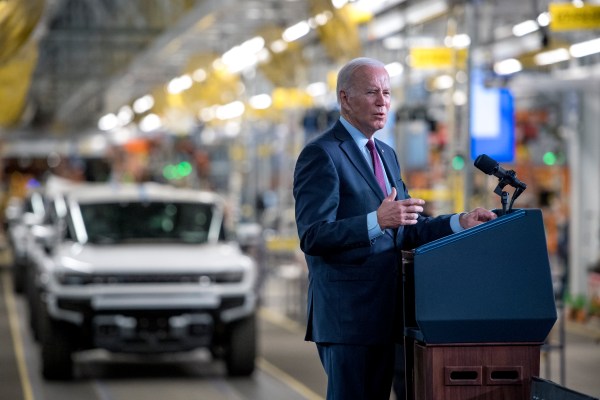For years, the U.S. lagged behind much of the rest of the world when it came to climate action. The European Union and its members were particularly critical, calling the U.S. out for its repeated refusals to sign the Kyoto Protocol and then for pulling out of the Paris Agreement under the Trump administration.
Then last year, the EU’s arguments changed seemingly overnight, from criticizing American intransigence to claiming that the country had gone too far.
The transformation was catalyzed when President Joe Biden signed the Inflation Reduction Act into law on August 16, 2022. The law didn’t just catapult the U.S. into a leading position on climate action, but it also added another sticking point to the increasingly fraught relationship between the U.S. and the EU.
The bill’s surprise passage ushered in $369 billion worth of stimulus and incentives aimed at boosting the country’s climate tech sector and its industrial base. In the process, it could help slash carbon pollution in the U.S. by about 40% — below 2005 levels — by 2030.
This should have brought cheers from Brussels. Instead, the bloc seethed with not-so-quiet frustration over “buy American” provisions. Within a month, the bloc said it would investigate whether the provisions of the law violated World Trade Organization rules.
Role of markets
For the last couple decades, the European approach to climate change has been heavily reliant on sticks over carrots. The centerpiece of EU climate policy has been emissions reduction targets supported by a carbon market, a blend of government regulation and liberal economics that have formed the backbone of many climate proposals.
Emissions trading is a concept cooked up in the U.S. in the late 1960s and early 1970s, when air pollution was spiraling out of control. Over the years, the U.S. has embraced emissions trading for specific pollutants like sulfur dioxide and nitrogen oxides. Carbon cap-and-trade never really caught on here, though. There are various regional markets, but a nationwide carbon market proposed in 2009 never made it past the House of Representatives thanks to the threat of a Republican filibuster in the Senate.
The EU’s carbon market is based on the very same concept of cap-and-trade, where maximum permissible emissions are set by regulators, leaving the specifics up to the market. Over time, the emissions cap is lowered, driving up the price of carbon credits and leveling the playing field for more expensive but lower emitting technologies. The EU was clearly hoping that its carbon market would become the global standard. That hasn’t quite happened.
In its carbon market, the EU had bought into the idea of a distinctly market-driven, American approach to pollution control, painstakingly building a robust market for carbon trading over several decades. The U.S., on the other hand, has completely abandoned the idea of a nationwide carbon market, instead embracing subsidies, what many might consider a stereotypically European approach. In other words, Europe went with sticks, while the U.S. went with carrots.
This reversal of roles could explain some of the EU’s frustration over the Inflation Reduction Act.
Softening stances
“There was certainly a lot of annoyance and outrage when it first was passed. But like us, the Europeans sometimes sort of pump themselves up over outrage about the Americans,” Charles Wessner, an adjunct professor at Georgetown University and senior adviser at the Center for Strategic and International Studies, told TechCrunch+.
Though the law clearly caught Europe off guard, the bloc’s initial exasperation soon softened. “Partly due to some cooler heads in Brussels, I think some of that outrage has gone down considerably,” Wessner said, adding that the Biden administration has worked to quell the furor, too. “In terms of the Europeans, I think they’re coming down and recognizing there’s much good in that and that there may be grounds for cooperation.”
Apart from diplomatic outreach, two other things appear to be helping to mend the relationship between the U.S. and EU, Wessner said. One is the Russian invasion of Ukraine, which has served as a reminder of the importance of U.S.–EU relations. The other is the challenge that China poses, particularly in the energy transition. “If we don’t cooperate on standards, the Chinese will set a de facto standard for the world,” he said.
Earlier this year, the EU announced a stimulus of its own called the Green Deal Industrial Plan. While not as robust as the Inflation Reduction Act, it does pay homage to it. The plan loosens some permitting rules for renewable energy projects and repurposes 245 million euros of loans and grants from the pandemic recovery fund.
It’s not hard to see why the EU would follow suit. Since it was signed, the Inflation Reduction Act has helped spur billions in investment in the U.S., from gigafactories to solar panel plants and more.
Trade war or arms race?
Ultimately, the Inflation Reduction Act hasn’t sparked a trade war between the U.S. and the EU like some observers predicted. Rather, it appears to have triggered a climate tech arms race. Instead of bickering at bargaining tables, the world’s first and third largest economies are now trying to one-up each other to see which one can develop the largest and most sophisticated climate tech industrial base.
Economists may take issue with some of the measures taken by both sides, but given that unchecked carbon pollution could slash global GDP by up to 4%, according to ratings firm S&P Global, it’s clear that the consequences of inaction are far greater. If this is the kind of heated competition that defines the next few decades, bring it on. We could use more of this.
